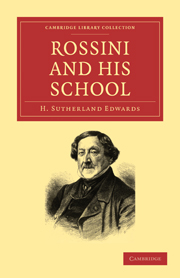Book contents
- Frontmatter
- Contents
- CHAP. I ROSSINI'S CHILDHOOD AND YOUTH
- CHAP. II LA PIETEA DEL PARAGONE
- CHAP. III ITALIAN OPERA UNTIL THE TIME OF ROSSINI
- CHAP. IV TANCREDI
- CHAP. V OPERATIC CUSTOMS IN ROSSINI'S TIME
- CHAP. VI ROSSINI AT NAPLES
- CHAP. VII PREPARATIONS FOR THE BARBER
- CHAP. VIII IL BARBIERE
- CHAP. IX ROSSINI AND THE COMIC IN MUSIC
- CHAP. X FROM OTELLO TO SEMIKAMIDE
- CHAP. XI ROSSINI ON HIS TRAVELS
- CHAP. XII DONIZETTI
- CHAP. XIII VERDI
- LIST OF ROSSINI'S PUBLISHED WORKS
CHAP. X - FROM OTELLO TO SEMIKAMIDE
Published online by Cambridge University Press: 29 August 2010
- Frontmatter
- Contents
- CHAP. I ROSSINI'S CHILDHOOD AND YOUTH
- CHAP. II LA PIETEA DEL PARAGONE
- CHAP. III ITALIAN OPERA UNTIL THE TIME OF ROSSINI
- CHAP. IV TANCREDI
- CHAP. V OPERATIC CUSTOMS IN ROSSINI'S TIME
- CHAP. VI ROSSINI AT NAPLES
- CHAP. VII PREPARATIONS FOR THE BARBER
- CHAP. VIII IL BARBIERE
- CHAP. IX ROSSINI AND THE COMIC IN MUSIC
- CHAP. X FROM OTELLO TO SEMIKAMIDE
- CHAP. XI ROSSINI ON HIS TRAVELS
- CHAP. XII DONIZETTI
- CHAP. XIII VERDI
- LIST OF ROSSINI'S PUBLISHED WORKS
Summary
In 1816, Rossini brought out at the San Carlo, of Naples, the second of his serious operas, or at least the second of those which were destined to make a mark: Otello. This work exhibited reforms of various kinds much more important than any that are to be noticed in Tancredi. Recitative is more sparingly used than in the earlier work, and for the first time it is accompanied by the full band. Now, too, Rossini banished the piano from the orchestra, where it had been allowed to remain long after its expulsion as an orchestral instrument from the bands of Germany and (thanks to Gluck) of France. Two years after its production at Naples Byron witnessed a representation of Otello at Venice and gives some account of it in one of his letters dated 1818. The libretto struck him as bad and ridiculous, but he praises the music, and the style in which it was executed. Lord Mount-Edgecumbe, when the work was given in London, must have been disgusted to find two of the leading parts assigned to bass voices. Iago is of necessity almost as important a character as Othello himself. Rossini's librettist kept him, nevertheless, a little too much in the back ground, while Roderigo, on the other hand, is too much brought forward.
- Type
- Chapter
- Information
- Rossini and his School , pp. 72 - 79Publisher: Cambridge University PressPrint publication year: 2009First published in: 1881



